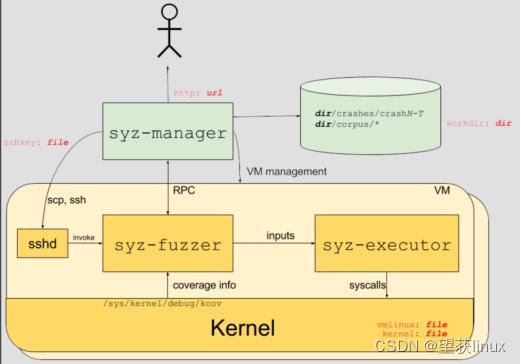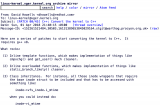目錄
1. 前言
2. ARM64棧幀結(jié)構(gòu)
3. 編譯階段
3.1 未開啟ftrace時(shí)的blk_update_request
3.2 開啟ftrace時(shí)的blk_update_request
4. 鏈接階段
4.1 未開啟ftrace時(shí)的blk_update_request
4.2 開啟ftrace時(shí)的blk_update_request
5. 運(yùn)行階段
5.1 ftrace_init執(zhí)行后的blk_update_request
5.2 設(shè)定trace函數(shù)blk_update_request
6. 鉤子函數(shù)的替換過程
7.總結(jié)
參考文檔
1. 前言
本文主要是根據(jù)閱碼場(chǎng) 《Linux內(nèi)核tracers的實(shí)現(xiàn)原理與應(yīng)用》視頻課程,我自己在aarch64上的實(shí)踐。通過觀察鉤子函數(shù)的創(chuàng)建過程以及替換過程,理解trace的原理。本文同樣以blk_update_request函數(shù)為例進(jìn)行說明。
kernel版本:5.10平臺(tái):arm64
2.ARM64棧幀結(jié)構(gòu)
在開始介紹arm64架構(gòu)下的ftrace之前,先來簡(jiǎn)要說明一下arm64棧幀的相關(guān)知識(shí)。arm64有31個(gè)通用寄存器r0-r30,其中r0-r7用于Parameter/result 寄存器; r29為Frame Pointer寄存器,r30為L(zhǎng)ink寄存器,指向上級(jí)函數(shù)的返回地址;SP為棧指針。將以如下代碼為例,說明它的棧幀結(jié)構(gòu):
/*
* ARCH: armv8
* GCC版本:aarch64-linux-gnu-gcc (Linaro GCC 5.4-2017.01) 5.4.1 20161213
*/
intfun2(int c,int d)
{
return0;
}
intfun1(int a,int b)
{
int c = 1;
int d = 2;
fun2(c, d);
return0;
}
intmain(int argc,char **argv)
{
int a = 0;
int b = 1;
fun1(a,b);
}
aarch64-linux-gnu-objdump -d a.out 反匯編后的結(jié)果為:
0000000000400530 《fun2》:
/* 更新sp到fun2的棧底 */
400530: d10043ff sub sp, sp, #0x10
400534: b9000fe0 str w0, [sp,#12]
400538: b9000be1 str w1, [sp,#8]
40053c: 52800000 mov w0, #0x0 // #0
400540: 910043ff add sp, sp, #0x10
400544: d65f03c0 ret
0000000000400548 《fun1》:
/* 分配48字節(jié)棧空間,先更新sp=sp-48, 再入棧x29, x30, 此時(shí)sp指向棧頂 */
400548: a9bd7bfd stp x29, x30, [sp,#-48]!
/* x29、sp指向棧頂*/
40054c: 910003fd mov x29, sp
/* 入棧fun1參數(shù)0 */
400550: b9001fa0 str w0, [x29,#28]
/* 入棧fun1參數(shù)1 */
400554: b9001ba1 str w1, [x29,#24]
/* 入棧fun1局部變量c */
400558: 52800020 mov w0, #0x1 // #1
40055c: b9002fa0 str w0, [x29,#44]
/* 入棧fun1局部變量d */
400560: 52800040 mov w0, #0x2 // #2
400564: b9002ba0 str w0, [x29,#40]
400568: b9402ba1 ldr w1, [x29,#40]
40056c: b9402fa0 ldr w0, [x29,#44]
/* 跳轉(zhuǎn)到fun2 */
400570: 97fffff0 bl 400530 《fun2》
400574: 52800000 mov w0, #0x0 // #0
400578: a8c37bfd ldp x29, x30, [sp],#48
40057c: d65f03c0 ret
0000000000400580 《main》:
/* 分配48字節(jié)棧空間,先更新sp=sp-48, 再入棧x29, x30, 此時(shí)sp指向棧頂*/
400580: a9bd7bfd stp x29, x30, [sp,#-48]!
/* x29、sp指向棧頂*/
400584: 910003fd mov x29, sp
/* 入棧main參數(shù)0 */
400588: b9001fa0 str w0, [x29,#28]
/* 入棧main參數(shù)1 */
40058c: f9000ba1 str x1, [x29,#16]
/* 入棧變量a */
400590: b9002fbf str wzr, [x29,#44]
400594: 52800020 mov w0, #0x1 // #1
/* 入棧變量b */
400598: b9002ba0 str w0, [x29,#40]
40059c: b9402ba1 ldr w1, [x29,#40]
4005a0: b9402fa0 ldr w0, [x29,#44]
/* 跳轉(zhuǎn)到fun1 */
4005a4: 97ffffe9 bl 400548 《fun1》
4005a8: 52800000 mov w0, #0x0 // #0
4005ac: a8c37bfd ldp x29, x30, [sp],#48
4005b0: d65f03c0 ret
4005b4: 00000000 .inst 0x00000000 ; undefined
對(duì)應(yīng)棧幀結(jié)構(gòu)為:

總結(jié)一下:通過對(duì)aarch64代碼反匯編的分析,可以得出:
1. 每個(gè)函數(shù)在入口處首先會(huì)分配棧空間,且一次分配,確定棧頂,之后sp將不再變化;
2. 每個(gè)函數(shù)的棧頂部存放的是caller的棧頂指針,即fun1的棧頂存放的是main棧頂指針;
3. 對(duì)于最后一級(jí)callee函數(shù),由于x29保存了上一級(jí)caller的棧頂sp指針,因此不在需要入棧保存,如示例中fun2執(zhí)行時(shí),此時(shí)x29指向fun1的棧頂sp
下面我們將根據(jù)是否開啟ftrace配置,并區(qū)分編譯階段、鏈接階段和運(yùn)行階段,分別查看鉤子函數(shù)的替換及構(gòu)建情況。
3. 編譯階段
3.1 未開啟ftrace時(shí)的blk_update_request
00000000000012ac 《blk_update_request》:
12ac: d10183ff sub sp, sp, #0x60
12b0: a9017bfd stp x29, x30, [sp,#16]
12b4: 910043fd add x29, sp, #0x10
12b8: a90253f3 stp x19, x20, [sp,#32]
12bc: a9035bf5 stp x21, x22, [sp,#48]
12c0: a90463f7 stp x23, x24, [sp,#64]
12c4: f9002bf9 str x25, [sp,#80]
12c8: aa0003f6 mov x22, x0
12cc: 53001c38 uxtb w24, w1
12d0: 2a0203f5 mov w21, w2
12d4: 2a1803e0 mov w0, w24
12d8: 94000000 bl 12c 《blk_status_to_errno》
...
在未使能內(nèi)核配置項(xiàng)CONFIG_FTRACE時(shí),反匯編blk_update_request函數(shù)可以看出,不包含鉤子函數(shù)。
3.2 開啟ftrace時(shí)的blk_update_request
0000000000003f10 《blk_update_request》:
3f10: d10183ff sub sp, sp, #0x60
3f14: a9017bfd stp x29, x30, [sp,#16]
3f18: 910043fd add x29, sp, #0x10
3f1c: a90253f3 stp x19, x20, [sp,#32]
3f20: a9035bf5 stp x21, x22, [sp,#48]
3f24: a90463f7 stp x23, x24, [sp,#64]
3f28: f9002bf9 str x25, [sp,#80]
3f2c: aa0003f6 mov x22, x0
3f30: 53001c38 uxtb w24, w1
3f34: 2a0203f5 mov w21, w2
3f38: aa1e03e0 mov x0, x30
3f3c: 94000000 bl 0 《_mcount》
...
在使能內(nèi)核配置項(xiàng)CONFIG_FTRACE時(shí),可以看到blk_update_request函數(shù)增加了如下部分:
3f3c: 94000000 bl 0 《_mcount》
那么 bl 0 《_mcount》 是由誰在何時(shí)插入的呢? 答案是編譯器在編譯時(shí)插入,編譯選項(xiàng)-pg -mrecord-mcoun會(huì)在編譯時(shí)在每個(gè)可trace函數(shù)插入bl 0 《_mcount》,并將所有可trace的函數(shù)放到一個(gè)__mcount_loc的section中。
通過查看blk-core.o的可重定位段,可以看到有大量的地址需要定位到_mcount函數(shù),其中3f3c地址正是位于blk_update_request,它會(huì)在鏈接階段被重定位到_mcount函數(shù)的地址。
ubuntu@VM-0-9-ubuntu:~/qemu/kernel/linux/block$ aarch64-linux-gnu-objdump -r blk-core.o | grep _mcount
0000000000000014 R_AARCH64_CALL26 _mcount
000000000000005c R_AARCH64_CALL26 _mcount
00000000000000ac R_AARCH64_CALL26 _mcount
0000000000000108 R_AARCH64_CALL26 _mcount
0000000000000164 R_AARCH64_CALL26 _mcount
00000000000001bc R_AARCH64_CALL26 _mcount
0000000000000214 R_AARCH64_CALL26 _mcount
...
0000000000003f3c R_AARCH64_CALL26 _mcount
...
我們還可以看到,blk-core.o有一個(gè).rela__mcount_loc的可重定位段,里面存放了所有需要可trace函數(shù)中需要重定位到函數(shù)_mcount的地址。
ubuntu@VM-0-9-ubuntu:~/qemu/kernel/linux/block$ aarch64-linux-gnu-objdump -r blk-core.o
...
RELOCATION RECORDS FOR [__mcount_loc]:
OFFSET TYPE VALUE
0000000000000000 R_AARCH64_ABS64 .text+0x0000000000000014
0000000000000008 R_AARCH64_ABS64 .text+0x000000000000005c
0000000000000010 R_AARCH64_ABS64 .text+0x00000000000000ac
0000000000000018 R_AARCH64_ABS64 .text+0x0000000000000108
...
00000000000001b8 R_AARCH64_ABS64 .text+0x0000000000003f3c
...
4. 鏈接階段
4.1 未開啟ftrace時(shí)的blk_update_request
未使能內(nèi)核配置項(xiàng)CONFIG_FTRACE時(shí),鏈接階段與編譯階段一樣,反匯編blk_update_request函數(shù)可以看出,不包含鉤子函數(shù)
4.2 開啟ftrace時(shí)的blk_update_request
ffff8000104e43c8 《blk_update_request》:
ffff8000104e43c8: d10183ff sub sp, sp, #0x60
ffff8000104e43cc: a9017bfd stp x29, x30, [sp,#16]
ffff8000104e43d0: 910043fd add x29, sp, #0x10
ffff8000104e43d4: a90253f3 stp x19, x20, [sp,#32]
ffff8000104e43d8: a9035bf5 stp x21, x22, [sp,#48]
ffff8000104e43dc: a90463f7 stp x23, x24, [sp,#64]
ffff8000104e43e0: f9002bf9 str x25, [sp,#80]
ffff8000104e43e4: aa0003f6 mov x22, x0
ffff8000104e43e8: 53001c38 uxtb w24, w1
ffff8000104e43ec: 2a0203f5 mov w21, w2
ffff8000104e43f0: aa1e03e0 mov x0, x30
ffff8000104e43f4: 97ed1fde bl ffff80001002c36c 《_mcount》
ffff8000104e43f8: 2a1803e0 mov w0, w24
ffff8000104e43fc: 97fff432 bl ffff8000104e14c4 《blk_status_to_errno》
...
在鏈接階段,使能內(nèi)核配置項(xiàng)CONFIG_FTRACE時(shí),可以看到編譯階段的如下代碼
3f3c: 94000000 bl 0 《_mcount》
在鏈接階段已經(jīng)被替換為:
ffff8000104e43f4: 97ed1fde bl ffff80001002c36c 《_mcount》
其中_mcount函數(shù)反匯編為:
ffff80001002c36c 《_mcount》:
ffff80001002c36c: d65f03c0 ret
5. 運(yùn)行階段
5.1ftrace_init執(zhí)行后的blk_update_request
(gdb) x/20i blk_update_request
0xffff8000104e43c8 《blk_update_request》: sub sp, sp, #0x60
0xffff8000104e43cc 《blk_update_request+4》: stp x29, x30, [sp,#16]
0xffff8000104e43d0 《blk_update_request+8》: add x29, sp, #0x10
0xffff8000104e43d4 《blk_update_request+12》: stp x19, x20, [sp,#32]
0xffff8000104e43d8 《blk_update_request+16》: stp x21, x22, [sp,#48]
0xffff8000104e43dc 《blk_update_request+20》: stp x23, x24, [sp,#64]
0xffff8000104e43e0 《blk_update_request+24》: str x25, [sp,#80]
0xffff8000104e43e4 《blk_update_request+28》: mov x22, x0
0xffff8000104e43e8 《blk_update_request+32》: uxtb w24, w1
0xffff8000104e43ec 《blk_update_request+36》: mov w21, w2
0xffff8000104e43f0 《blk_update_request+40》: mov x0, x30
0xffff8000104e43f4 《blk_update_request+44》: nop
0xffff8000104e43f8 《blk_update_request+48》: mov w0, w24
0xffff8000104e43fc 《blk_update_request+52》: bl 0xffff8000104e14c4 《blk_status_to_errno》
內(nèi)核在start_kernel執(zhí)行時(shí),會(huì)調(diào)用ftrace_init,它會(huì)將所有可trace函數(shù)中的_mcount進(jìn)行替換,如上可以看出鏈接階段的 bl ffff80001002c36c 《_mcount》 已經(jīng)被替換為nop指令
5.2 設(shè)定trace函數(shù)blk_update_request
執(zhí)行如下命令來trace函數(shù)blk_update_request
ubuntu@VM-0-9-ubuntu:~$echo blk_update_request 》 /sys/kernel/debug/tracing/set_ftrace_filter
ubuntu@VM-0-9-ubuntu:~$echo function 》 /sys/kernel/debug/tracing/current_tracer
我們?cè)賮聿榭碽lk_update_request反匯編代碼
(gdb) x/20i blk_update_request
0xffff8000104e43c8 《blk_update_request》: sub sp, sp, #0x60
0xffff8000104e43cc 《blk_update_request+4》: stp x29, x30, [sp,#16]
0xffff8000104e43d0 《blk_update_request+8》: add x29, sp, #0x10
0xffff8000104e43d4 《blk_update_request+12》: stp x19, x20, [sp,#32]
0xffff8000104e43d8 《blk_update_request+16》: stp x21, x22, [sp,#48]
0xffff8000104e43dc 《blk_update_request+20》: stp x23, x24, [sp,#64]
0xffff8000104e43e0 《blk_update_request+24》: str x25, [sp,#80]
0xffff8000104e43e4 《blk_update_request+28》: mov x22, x0
0xffff8000104e43e8 《blk_update_request+32》: uxtb w24, w1
0xffff8000104e43ec 《blk_update_request+36》: mov w21, w2
0xffff8000104e43f0 《blk_update_request+40》: mov x0, x30
0xffff8000104e43f4 《blk_update_request+44》: bl 0xffff80001002c370 《ftrace_caller》
0xffff8000104e43f8 《blk_update_request+48》: mov w0, w24
0xffff8000104e43fc 《blk_update_request+52》: bl 0xffff8000104e14c4 《blk_status_to_errno》
可以看到之前在blk_update_request的nop指令被替換成
bl 0xffff80001002c370 《ftrace_caller》
繼續(xù)反匯編ftrace_caller得到如下的匯編代碼:
(gdb) disassemble ftrace_caller
Dump of assembler code for function ftrace_caller:
0xffff80001002c374 《+0》: stp x29, x30, [sp,#-16]!
0xffff80001002c378 《+4》: mov x29, sp
// x30是blk_update_request的lr,-4是當(dāng)前執(zhí)行函數(shù)的入口地址,也就是ftrace_caller的ip
// 它將作為參數(shù)0傳遞給ftrace_ops_no_ops
0xffff80001002c37c 《+8》: sub x0, x30, #0x4
// 參考前面arm64棧幀結(jié)構(gòu),x29指向上一級(jí)函數(shù)blk_update_request棧頂
//[x29]指向blk_mq_end_request函數(shù)的棧頂
//[[x29]+8]為blk_mq_end_request的ip(實(shí)際是ip的下條指令)
0xffff80001002c380 《+12》: ldr x1, [x29]
0xffff80001002c384 《+16》: ldr x1, [x1,#8]
0xffff80001002c388 《+20》: bl 0xffff800010188ffc 《ftrace_ops_no_ops》
0xffff80001002c38c 《+24》: nop
0xffff80001002c390 《+28》: ldp x29, x30, [sp],#16
0xffff80001002c394 《+32》: ret
End of assembler dump.
可以看到ftrace_caller會(huì)調(diào)用ftrace_ops_no_ops,我們?cè)趂trace_ops_no_ops源碼中看到它會(huì)遍歷ftrace_ops_list鏈表,并執(zhí)行這個(gè)鏈表上的回調(diào)函數(shù),這里看下ftrace_ops_list上都鏈接了哪些func
(gdb) p *ftrace_ops_list
$4 = {
func = 0xffff8000101a0b1c 《function_trace_call》, //ftrace_ops_list鏈表唯一func
next = 0xffff800011c5a438 《ftrace_list_end》, //說明ftrace_ops_list鏈表只有一個(gè)func
flags = 8273,
private = 0xffff800011cf94e8 《global_trace》,
saved_func = 0xffff8000101a0b1c 《function_trace_call》,
local_hash = {
notrace_hash = 0xffff800010cf7118 《empty_hash》,
filter_hash = 0xffff00000720af80,
regex_lock = {
owner = {
counter = 0
},
......
從ftrace_ops_list鏈表中可以看到只有一個(gè)function_trace_call函數(shù)組成,因此可以說ftrace_caller最終會(huì)調(diào)用到function_trace_call。
通過前面的分析,我們一步步找到了blk_update_request的鉤子函數(shù)function_trace_call,其函數(shù)原型如下,其中參數(shù)ip指向ftrace_caller,參數(shù)parent_ip指向blk_mq_end_request:
staticvoid
function_trace_call(unsignedlong ip, unsignedlong parent_ip,
struct ftrace_ops *op, struct pt_regs *pt_regs)
下一節(jié)我們將追蹤鉤子函數(shù)的構(gòu)造以及替換過程。
6. 鉤子函數(shù)的替換過程
前面我們看到blk_update_request的nop指令被替換成bl ftrace_caller,那么此處的ftrace_caller是在哪里定義的呢?我們可以看到arch/arm64/kernel/entry-ftrace.S有如下的定義:
/*
* void ftrace_caller(unsigned long return_address)
* @return_address: return address to instrumented function
*
* This function is a counterpart of _mcount() in ‘static’ ftrace, and
* makes calls to:
* - tracer function to probe instrumented function‘s entry,
* - ftrace_graph_caller to set up an exit hook
*/
SYM_FUNC_START(ftrace_caller)
mcount_enter
mcount_get_pc0 x0 // function’s pc
mcount_get_lr x1 // function‘s lr
SYM_INNER_LABEL(ftrace_call, SYM_L_GLOBAL) // tracer(pc, lr);
nop // This will be replaced with “bl xxx”
// where xxx can be any kind of tracer.
#ifdef CONFIG_FUNCTION_GRAPH_TRACER
SYM_INNER_LABEL(ftrace_graph_call, SYM_L_GLOBAL) // ftrace_graph_caller();
nop // If enabled, this will be replaced
// “b ftrace_graph_caller”
#endif
mcount_exit
SYM_FUNC_END(ftrace_caller)
通過 gdb可以看到ftrace_caller的反匯編代碼如下:
(gdb) disassemble ftrace_caller
Dump of assembler code for function ftrace_caller:
0xffff80001002c370 《+0》: stp x29, x30, [sp,#-16]!
0xffff80001002c374 《+4》: mov x29, sp
0xffff80001002c378 《+8》: sub x0, x30, #0x4
0xffff80001002c37c 《+12》: ldr x1, [x29]
0xffff80001002c380 《+16》: ldr x1, [x1,#8]
0xffff80001002c384 《+20》: nop /*ftrace_call*/
0xffff80001002c388 《+24》: nop /*ftrace_graph_call,暫不討論*/
0xffff80001002c38c 《+28》: ldp x29, x30, [sp],#16
0xffff80001002c390 《+32》: ret
End of assembler dump.
當(dāng)執(zhí)行echo blk_update_request 》set_ftrace_filter時(shí)相當(dāng)于使能了blk_update_request的鉤子替換標(biāo)志,當(dāng)執(zhí)行echo function 》current_tracer時(shí)會(huì)檢查這個(gè)標(biāo)志,并執(zhí)行替換,它會(huì)產(chǎn)生如下的調(diào)用鏈:
/sys/kernel/debug/tracing # echo function 》 current_tracer
[ 45.632002] CPU: 0 PID: 111 Comm: sh Not tainted 5.10.0-dirty #35
[ 45.632457] Hardware name: linux,dummy-virt (DT)
[ 45.632697] Call trace:
[ 45.632981] dump_backtrace+0x0/0x1f8
[ 45.633169] show_stack+0x2c/0x7c
[ 45.634039] ftrace_modify_all_code+0x38/0x118
[ 45.634269] arch_ftrace_update_code+0x10/0x18
[ 45.634495] ftrace_run_update_code+0x2c/0x48
[ 45.634727] ftrace_startup_enable+0x40/0x4c
[ 45.634943] ftrace_startup+0xec/0x11c
[ 45.635137] register_ftrace_function+0x68/0x84
[ 45.635369] function_trace_init+0xa0/0xc4
[ 45.635574] tracer_init+0x28/0x34
[ 45.635768] tracing_set_tracer+0x11c/0x17c
[ 45.635982] tracing_set_trace_write+0x124/0x170
[ 45.636224] vfs_write+0x16c/0x368
[ 45.636409] ksys_write+0x74/0x10c
[ 45.636594] __arm64_sys_write+0x28/0x34
[ 45.636923] el0_svc_common+0xf0/0x174
[ 45.637138] do_el0_svc+0x84/0x90
[ 45.637330] el0_svc+0x1c/0x28
[ 45.637510] el0_sync_handler+0x3c/0xac
[ 45.637721] el0_sync+0x140/0x180
進(jìn)一步查看ftrace_modify_all_code的代碼,我們可以看到如下的調(diào)用流程:
ftrace_modify_all_code(command)
--ftrace_update_ftrace_func(ftrace_ops_list_func)
|--pc = (unsignedlong)&ftrace_call
| //此處ftrace_ops_list_func為ftrace_ops_no_ops,
| //因此會(huì)返回bl ftrace_ops_no_ops給new*/
|--new = aarch64_insn_gen_branch_imm(pc, (unsignedlong)ftrace_ops_list_func,
| AARCH64_INSN_BRANCH_LINK);
--ftrace_modify_code(pc, 0, new, false)
如上,ftrace_modify_code通過修改text段,將指令ftrace_call替換為bl ftrace_ops_no_ops,此處是第一次替換;
ftrace_modify_all_code(command)
--ftrace_replace_code(mod_flags | FTRACE_MODIFY_ENABLE_FL);
--do_for_each_ftrace_rec(pg, rec) {
__ftrace_replace_code(rec, enable);
} while_for_each_ftrace_rec();
如上,會(huì)遍歷每一個(gè)可trace的函數(shù),對(duì)于使能了替換標(biāo)記的函數(shù),將其nop替換為bl ftrace_caller,此處是第二次替換,ftrace_caller也就是我們所認(rèn)為的鉤子函數(shù)。
7.總結(jié)
到此我們已經(jīng)分析完了ftrace的各個(gè)階段的行為,以及鉤子函數(shù)的替換過程,基本上包含如下過程:
1. 編譯階段。通過編譯選項(xiàng) -pg -mrecord-mcount 在每個(gè)支持ftrace的函數(shù)中插入bl 0 《_mcount》指令
2. 鏈接階段。會(huì)根據(jù)重定位段將bl 0 《_mcount》指令地址重定位為_mcount函數(shù)地址。
3. 運(yùn)行階段 (1)ftrace_init:會(huì)將可trace函數(shù)中的bl _mcount替換為nop指令;(2)執(zhí)行echo blk_update_request 》set_ftrace_filter:會(huì)使能blk_update_request的鉤子函數(shù)替換標(biāo)記(nop替換為ftrace_caller); (3)執(zhí)行echofunction 》 current_tracer:觸發(fā)兩步替換:第一步,ftrace_caller中ftrace_call被替換為ftrace_ops_no_ops;第二步,blk_update_request中的nop被替換為ftrace_caller。ftrace_caller最終會(huì)調(diào)用到function_trace_call,它會(huì)記錄函數(shù)調(diào)用堆棧信息,并將結(jié)果寫入 ring buffer,用戶可以通過/sys/kernel/debug/tracing/trace文件讀取該 ring buffer 中的內(nèi)容。
最后,給出一個(gè)通過ftrace跟蹤dd寫入操作的例子,腳本為ftrace.sh
#!/bin/bash
debugfs=/sys/kernel/debug
echo nop 》 $debugfs/tracing/current_tracer
echo 0 》 $debugfs/tracing/tracing_on
echo $$ 》 $debugfs/tracing/set_ftrace_pid
echo function 》 $debugfs/tracing/current_tracer
#replace test_proc_show by your function name
echo ksys_write 》 $debugfs/tracing/set_ftrace_filter
echo 1 》 $debugfs/tracing/tracing_on
exec “$@”
ubuntu@VM-0-9-ubuntu:$ 。/ftrace.sh dd if=/dev/zero of=test bs=512 count=1048576
執(zhí)行結(jié)果:
root@VM-0-9-ubuntu:# cat /sys//kernel/debug/tracing/trace
# tracer: function
#
# entries-in-buffer/entries-written: 102454/1048579 #P:2
#
# _-----=》 irqs-off
# / _----=》 need-resched
# | / _---=》 hardirq/softirq
# || / _--=》 preempt-depth
# ||| / delay
# TASK-PID CPU# |||| TIMESTAMP FUNCTION
# | | | |||| | |
dd-32307 [000] .... 1380661.568624: vfs_write 《-SyS_write
dd-32307 [000] .... 1380661.568626: vfs_write 《-SyS_write
dd-32307 [000] .... 1380661.568630: vfs_write 《-SyS_write
dd-32307 [000] .... 1380661.568632: vfs_write 《-SyS_write
......
責(zé)任編輯:haq
-
Linux
+關(guān)注
關(guān)注
87文章
11329瀏覽量
209967
原文標(biāo)題:ftrace學(xué)習(xí)筆記
文章出處:【微信號(hào):gh_6fde77c41971,微信公眾號(hào):FPGA干貨】歡迎添加關(guān)注!文章轉(zhuǎn)載請(qǐng)注明出處。
發(fā)布評(píng)論請(qǐng)先 登錄
相關(guān)推薦
騰訊云內(nèi)核團(tuán)隊(duì)修復(fù)Linux關(guān)鍵Bug
嵌入式學(xué)習(xí)-飛凌嵌入式ElfBoard ELF 1板卡-Linux內(nèi)核移植之內(nèi)核簡(jiǎn)介
飛凌嵌入式ElfBoard ELF 1板卡-Linux內(nèi)核移植之內(nèi)核簡(jiǎn)介
deepin社區(qū)亮相第19屆中國Linux內(nèi)核開發(fā)者大會(huì)
linux內(nèi)核中通用HID觸摸驅(qū)動(dòng)

詳解linux內(nèi)核的uevent機(jī)制
linux驅(qū)動(dòng)程序如何加載進(jìn)內(nèi)核
Linux內(nèi)核測(cè)試技術(shù)

Linux內(nèi)核中的頁面分配機(jī)制

歡創(chuàng)播報(bào) 華為宣布鴻蒙內(nèi)核已超越Linux內(nèi)核
QNX與Linux基礎(chǔ)差異對(duì)比
使用 PREEMPT_RT 在 Ubuntu 中構(gòu)建實(shí)時(shí) Linux 內(nèi)核

C++在Linux內(nèi)核開發(fā)中從爭(zhēng)議到成熟





 Linux內(nèi)核ftrace的學(xué)習(xí)
Linux內(nèi)核ftrace的學(xué)習(xí)










評(píng)論